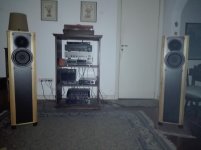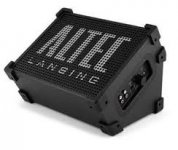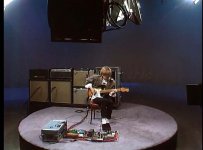Wow?wow!
Very few people have access to the back of their unit. They're almost always on a shelf against a wall. They slide it part way out on the shelf and bend over their unit from the front to make connections.
Last edited:
Not being familiar with this particular amp, I simply assumed the chassis mounts to the top of the housing, valves hanging down, as in many Fender guitar amps. Which, of course, would make the lettering right side up....They slide it part way out on the shelf and bend over their unit from the front to make connections.
-Gnobuddy
Probably because it's a relatively inexpensive way to make a really heavy-duty mounting plate, big enough for four mounting bolts, and beefy enough to cope with the weight of the transformer even during rough handling....But then why did they solder (weld) it?
It's just one big flat steel plate - much simpler than several cut and bent metal mounting flanges, plus mounting bolts to hold them to the transformer core, no?
By all accounts, Peavey got their start and early successes by making reliable, good quality equipment at lower prices than the competition, using modern manufacturing methods and cost-effective construction.
These days nobody says "reliable", "good quality", and "Peavey" in the same breath. They seem to have completely lost their way, and the people that run the company lost all focus on quality. What a pity. (If you haven't seen it, Google for and watch the episode of "Undercover Boss" featuring Peavey. It gives us a pretty ugly look at the way Peavey was being managed and run at the time of the filming.
But before they completely lost their way, at one time they did do some clever things to cut costs without cutting quality. Leo Fender would have approved, as he himself did exactly the same thing whenever possible.
-Gnobuddy
Gnobuddy
Yes, what look like screws can be bolts ... I assumed they were screws that were located from inside the chassis outwards, threaded into the metal support plate and what I thought I would see would be the tips of them rusted ... it is not possible to discern, but for the case it is the same, screws or bolts .....
Undoubtedly, it is designed to be placed upside down, something very common in "heads" of guitar amplifiers.
What they mention of the copper ring, is in the power transformer, and the mystery of the welding is clearly in the coupling transformer of the outlet valves, it is very far from them, and all the components are generously separated from each other just to minimize the overheating of them, since the heat rises, affecting the whole in general.
These guys knew what they were doing, since as you say the amplifier is located upside down, as we checked in the silkscreen of the 12AX7 valve.
Yes, what look like screws can be bolts ... I assumed they were screws that were located from inside the chassis outwards, threaded into the metal support plate and what I thought I would see would be the tips of them rusted ... it is not possible to discern, but for the case it is the same, screws or bolts .....
Undoubtedly, it is designed to be placed upside down, something very common in "heads" of guitar amplifiers.
What they mention of the copper ring, is in the power transformer, and the mystery of the welding is clearly in the coupling transformer of the outlet valves, it is very far from them, and all the components are generously separated from each other just to minimize the overheating of them, since the heat rises, affecting the whole in general.
These guys knew what they were doing, since as you say the amplifier is located upside down, as we checked in the silkscreen of the 12AX7 valve.
That's what I thought, makes perfect sense and I presumed that's why no one had mentioned it beforeWow?
Very few people have access to the back of their unit. They're almost always on a shelf against a wall. They slide it part way out on the shelf and bend over their unit from the front to make connections.
That also makes perfect senseNot being familiar with this particular amp, I simply assumed the chassis mounts to the top of the housing, valves hanging down, as in many Fender guitar amps. Which, of course, would make the lettering right side up.
-Gnobuddy
That also makes perfect sense
Practicing empathy ?
that's good, but do not leave me out ...
It's like the Heinz ketchup plastic squeeze bottle label.
Yes, but the wife still puts it back in the fridge upside down.
Every time.
Wow?
Very few people have access to the back of their unit. They're almost always on a shelf against a wall. They slide it part way out on the shelf and bend over their unit from the front to make connections.
Hi Cal
Yes, I had that problem until I decided to face the possibility of a divorce.
It was hard, but I won, and in the living room you can see all the wires in sight, which was the reason for the discord.
I also modified the furniture adding wheels in the base, you just turn it and you have all the connections accessible.
That was another concession, the wheels were also objected by WAF, in their eyes they also looked frightening as the cables, so I added pieces of wood and they were hidden.
I must clarify, recently was our 42nd wedding anniversary, this consensus would not have been achieved long ago, time can do everything ...
Attachments
You are undoubtedly almost probably also correctUndoubtedly, it is designed to be placed upside down, something very common in "heads" of guitar amplifiers.
Things get weird with guitar amps, though! The ergonomics are invariably lousy (dumb, for the context of this thread!), and seem to have been that way for about eighty or ninety years now, ever since the very first electric guitar amps of the late 1920s and early 1930s.All my diyAudio equipment have the connections on the front, beautiful and practical.... And not the least bit dumb
If the guitar amp controls and connections are on the front, the amp ends up on the floor behind the guitarist, aimed at his/her calves so he/she can't hear any of the treble content. The alternative is to have the amp facing away from the audience, even more unacceptable.
One could put the controls on the back, and the amp in front of the guitarist, but in that case, the speaker is facing away from him/her, so this is even worse than having the speaker aimed at your calves.
Some guitar amps have controls and inputs on the top, which doesn't help the situation in any way. Fender helpfully chrome-plated the top control panel on their Blues Junior, so that reflections from overhead lighting make it completely impossible to read the lettering next to the controls.
Guitarists have become so used to hearing (or rather, not hearing properly!) their amps placed behind them, that even separate heads and cabs are almost invariably placed behind the guitarist.
The best solution I can think of is a combo guitar amp with two speakers driven by the same valve power amp, one firing forwards, one rearwards, and controls on top. It would be placed in front of the guitarist. The front, and particularly the back panel would be tilted to aim the speaker upwards, off the floor, and up towards the guitarists face. Now the guitarist has at least a chance of hearing the same sound as the audience.
The obvious downsides are extra weight, bulk, and cost due to the second speaker. A speaker attenuator for the rear-facing speaker might also be needed, so that more sound goes to the audience and less back to the guitarist for monitoring.
Since this doesn't already exist, I guess either the lack of proper monitoring capability doesn't bother most guitarists, or guitar amp manufacturers don't want to risk breaking with tradition and creating something that looks too different from amps of the past.
-Gnobuddy
You are undoubtedly almost probably also correct
Very kind of you to include me ...
Last edited:
....... The best solution I can think of is a combo guitar amp with two speakers driven by the same valve power amp, one firing forwards, one rearwards, and controls on top. It would be placed in front of the guitarist. The front, and particularly the back panel would be tilted to aim the speaker upwards, off the floor, and up towards the guitarists face. Now the guitarist has at least a chance of hearing the same sound as the audience......
So this does not have much use?
I think I do not understand well .....
Attachments
That foldback wedge monitor is exactly what is completely missing from guitar amps!So this does not have much use?
I think I do not understand well .....
Even on small stages, singers cannot perform well without some sort of foldback monitor. They always have some sort of monitor aimed at their ears - either side-fill monitors on the sides of the stage, wedge monitors on the floor, personal mini-monitors on the mic stand itself, or these days, in-ear monitoring.
But the guitarist usually doesn't have a monitor, certainly not at small gigs (bar or coffee-shop or restaurant, say.) Instead, the guitar is behind him/her, and he/she is trying to hear with the back of his/her ears. Or worse, with the back of his legs!
Look at the attached picture (Eric Johnson himself) as an example. He is known for his amazing guitar tone, and his amazing perfectionism. He has a wall of guitar amps to get his "tone". But all of them are placed behind him - and even with all that trouble, he hasn't bothered to set up a monitor or speaker in front of him - because it would require microphones, a mixing engineer, a mixer, power amps, and foldback monitors. Too much stuff for an obviously small demo or performance like the one in the photo.
My idea was to build monitoring into the guitar amp itself. Something a guitarist can carry in one hand, as usual for small gigs and private performances. The amp would have, in effect, built-in foldback monitoring, via a speaker on the rear of the amp, facing backwards at the guitarist.
-Gnobuddy
Attachments
I don't know, man, looks like all those amps are miked up to me. That kinda implies a mixer, engineer, and some sort of recording gear, and adding a power amp and wedge is pretty trivial at that point.
I'm thinking there's a fairly strong relationship between the fact that there ARE mikes but not wedges, the relative positioning of the amplifiers re: EJ's ears, the typical off-axis and non-perpendicular placement of recording microphones for guitar amplifiers, and the fact that it's easy enough to add tweeters to guitar amps to improve dispersion but hardly anyone ever does... I think it's all a conspiracy, man, to listen to overdriven electric guitar amps off-axis!
I don't recognize the middle head, but the Marshall on the left is likely either a 50 or 100 watt nominal and the two Supers stacked on the right are 40-45 each; is that a Hiwatt? In any case, the Marshall is unlikely to spend much of its time OUT of overdrive, and Eric Johnson isn't having ANY trouble hearing any of those amplifiers from where he's sitting at all. On the contrary, I think he's sitting where he likes the way they sound. And, personally, I think Eric Johnson knows a LOT about how he wants them to sound.
Of course, I've been indoctrinated into the orthodoxy, so I instinctively assault change as evil. Anyone see any firewood?
I'm thinking there's a fairly strong relationship between the fact that there ARE mikes but not wedges, the relative positioning of the amplifiers re: EJ's ears, the typical off-axis and non-perpendicular placement of recording microphones for guitar amplifiers, and the fact that it's easy enough to add tweeters to guitar amps to improve dispersion but hardly anyone ever does... I think it's all a conspiracy, man, to listen to overdriven electric guitar amps off-axis!
I don't recognize the middle head, but the Marshall on the left is likely either a 50 or 100 watt nominal and the two Supers stacked on the right are 40-45 each; is that a Hiwatt? In any case, the Marshall is unlikely to spend much of its time OUT of overdrive, and Eric Johnson isn't having ANY trouble hearing any of those amplifiers from where he's sitting at all. On the contrary, I think he's sitting where he likes the way they sound. And, personally, I think Eric Johnson knows a LOT about how he wants them to sound.
Of course, I've been indoctrinated into the orthodoxy, so I instinctively assault change as evil. Anyone see any firewood?
Well, I'll take some wood to warm my environment, start feeling cold around here ...
I think that this photo is surpassed, I still do not understand, I have seen in the last years the monitoring of the sound emitted by the musicians with these monitors ...It's a common practice, because "it's missing" ?
Also, I do not think it is necessary to be a big "golden ears" to hear the sound coming from behind.
We are talking about "easy" and live music, not listening to the harmonic details of a violoncello, and sitting in the ideal triangle of a living room ....
I think that this photo is surpassed, I still do not understand, I have seen in the last years the monitoring of the sound emitted by the musicians with these monitors ...It's a common practice, because "it's missing" ?
Also, I do not think it is necessary to be a big "golden ears" to hear the sound coming from behind.
We are talking about "easy" and live music, not listening to the harmonic details of a violoncello, and sitting in the ideal triangle of a living room ....
That was kinda my point - here is a guitarist who is known for being picky about equipment, he has an enormous and complex set-up, and he still has no monitoring...most probably because he's been playing guitar without a monitor since he was ten years old, and has grown used to not hearing the sound the amp is actually making, just like every other electric guitarist!...And, personally, I think Eric Johnson knows a LOT about how he wants them to sound...
As everyone who's played e-guitar knows, the guitar amp itself doesn't sound much like the final mixed and produced in-the-mix guitar sound. Most guitarists want to hear their amp direct - not the final subdued, tamed-down, EQ'd, smoothed out, version in the final mix. And their amps don't really allow them to do this.
I also think most e-guitarists play live with a much too bright guitar tone that would tear your face off if you were facing the amp and it was pointed at your ears. They can't tell, because they're facing away from the amp.
If it's a bigger gig and there is a sound man, he has to turn down the treble to make the FOH mix sound good. If it's a small gig, the audience is subjected to the harsh, far-too-bright, guitar sound.
Maybe I'm the only electric-guitar player on earth who's bothered by this. But somehow, I doubt it!
-Gnobuddy
Do you ever listen critically to your home Hi-Fi that way, with your back to the speakers? So much midrange and treble is lost. Sure, you can "hear" the music, but half of the detail is gone.I do not think it is necessary to be a big "golden ears" to hear the sound coming from behind.
Maybe the audience doesn't care - but every good musician does care, a great deal, about how his/her instrument sounds. Musicians spend enormous amounts of time, hard work, and money, trying to improve their tone even the tiniest little bit. Then guitarists throw much of it away, by being unable to hear themselves properly.We are talking about "easy" and live music, not listening to the harmonic details of a violoncello
An e-guitar is more capable of abuse than a violin - the e-guitar can make so much harsh treble that it hurts the audience's ears, and frequently that is the case at small live gigs. I think this is partly because the guitarist can't hear himself properly, since the amp is usually on the floor behind him.
You speak of monitoring for the guitarist being common - yet I have never seen it except at a very big gig. The live acts I see are usually no more than two, three or four musicians at a restaurant, wedding, or other small venue - and the guitarist never has monitoring, and usually has the amp behind him, and usually has too-bright tone, and is too loud for the mix.
But I think I'm increasingly off-topic for this thread, so enough from me.
-Gnobuddy
- Status
- This old topic is closed. If you want to reopen this topic, contact a moderator using the "Report Post" button.
- Home
- Live Sound
- Instruments and Amps
- The dumbest thing I've ever seen in amp construction....


